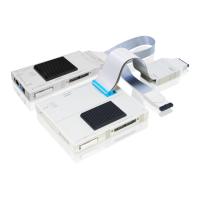PQIII Debugger | 39
©
1989-2021 Lauterbach GmbH
SYStem.Option.OVERLAY Enable overlay support
Default: OFF.
Example:
SYStem.Option.PERSTOP Stop on-chip peripherals in debug mode
Default: ON. If enabled the debugger will halt the on-chip peripherals of the processor while in debug mode.
memory accesses and cache snoops of e.g. TSEC, USB etc will not take place and memory spaces of
some peripherals are inaccessible. If disabled, the on-chip peripherals will stay active also during debug
mode. The data buffers of TSEC etc. can overflow, because the target application does not process the data
when stopped.
Format: SYStem.Option.OVERLAY [ON | OFF | WithOVS]
ON Activates the overlay extension and extends the address scheme of the
debugger with a 16 bit virtual overlay ID. Addresses therefore have the
format <overlay_id>:<address>. This enables the debugger to handle
overlaid program memory.
OFF Disables support for code overlays.
WithOVS Like option ON, but also enables support for software breakpoints. This
means that TRACE32 writes software breakpoint opcodes to both, the
execution area (for active overlays) and the storage area. This way, it is
possible to set breakpoints into inactive overlays. Upon activation of the
overlay, the target’s runtime mechanisms copies the breakpoint opcodes to
the execution area. For using this option, the storage area must be readable
and writable for the debugger.
SYStem.Option.OVERLAY ON
Data.List 0x2:0x11c4
; Data.List <overlay_id>:<address>
Format: SYStem.Option.PERSTOP [ON | OFF]
NOTE: If SYStem.Option.PERSTOP is disabled, it is recommended to also disable
SYStem.Option.DCFREEZE, in order to see the memory accesses performed by
the peripherals.

